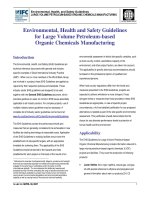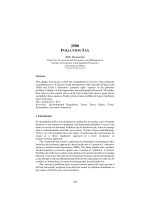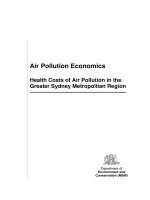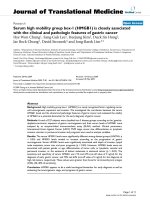Environmental Adaptations and Stress Tolerance of Plants in the Era of Climate Change pptx
Bạn đang xem bản rút gọn của tài liệu. Xem và tải ngay bản đầy đủ của tài liệu tại đây (9.67 MB, 532 trang )
Environmental Adaptations
and Stress Tolerance of Plants
in the Era of Climate Change
Parvaiz Ahmad
●
M.N.V. Prasad
Editors
Environmental
Adaptations and Stress
Tolerance of Plants
in the Era of Climate
Change
Editors
Parvaiz Ahmad
Department of Botany
Amar Singh College
University of Kashmir
Srinagar, Jammu and Kashmir
India
M.N.V. Prasad
Department of Plant Sciences
University of Hyderabad
Andhra Pradesh, Hyderabad 500 046
India
,
ISBN 978-1-4614-0814-7 e-ISBN 978-1-4614-0815-4
DOI 10.1007/978-1-4614-0815-4
Springer New York Dordrecht Heidelberg London
Library of Congress Control Number: 2011938457
© Springer Science+Business Media, LLC 2012
All rights reserved. This work may not be translated or copied in whole or in part without the
written permission of the publisher (Springer Science+Business Media, LLC, 233 Spring
Street, New York, NY 10013, USA), except for brief excerpts in connection with reviews or
scholarly analysis. Use in connection with any form of information storage and retrieval,
electronic adaptation, computer software, or by similar or dissimilar methodology now
known or hereafter developed is forbidden.
The use in this publication of trade names, trademarks, service marks, and similar terms, even if
they are not identifi ed as such, is not to be taken as an expression of opinion as to whether or not
they are subject to proprietary rights.
Printed on acid-free paper
Springer is part of Springer Science+Business Media (www.springer.com)
v
Any external factor that imposes negative impact on growth and development
of the plant is known as stress. Plants often experience abiotic stress like
drought, salinity, alkalinity, temperature, UV-radiations, oxygen defi ciency,
etc. Abiotic stress is responsible for the huge crop loss and reduced yield
more than 50% of some major crops. Ion imbalance and osmotic stress is the
primary effect of abiotic stress. Prolonged exposure to primary stress causes
secondary stress through the generation of reactive oxygen species (ROS).
These are deleterious for the plants as it causes oxidative damage by reacting
with biomolecules. Plants are able to perceive the external and internal sig-
nals and are then used by the plant to regulate various responses to stress.
Plants respond the abiotic stress by up- and downregulation of genes respon-
sible for the synthesis of osmolytes, osmoprotectants, and antioxidants.
Stress-responsive genes and gene products including proteins are expressed
and provide tolerance to the plant. To understand the physiological, biochem-
ical, and molecular mechanisms for abiotic stress, perception, transduction,
and tolerance is still a challenge before plant biologists.
The chapters in this book deal with the effect of different abiotic stresses
on plant metabolism and responses of the plants to withstand the stress.
Chapter 1 describes involvement of different osmolytes, osmoprotectants,
and antioxidants during abiotic stress. Chapter 2 deals with the role of halo-
phytes in understanding and managing abiotic stress. Chapter 3 addresses the
effect and defense mechanisms in plants under UV stress. Chapter 4 throws
light on the potassium uptake and its role under abiotic stress. Chapters 5 – 7
deal with the effect of temperature (heat, chilling) on plants and their
responses. Chapter 8 deals with the formation and function of roots under
stress. Chapter 9 is concerned with role of ROS and NO under abiotic stress.
Chapter 10 throws light on nitrogen infl ow and nitrogen use effi ciency (NUE)
under stress. Chapter 11 addresses Am symbiosis and soil interaction under
abiotic stress. Chapter 12 deals with the role of small RNA in abiotic stress.
Chapter 13 describes the involvement of transcription factors (TFs) under
abiotic stress. Chapters 14 – 17 deal with the involvement of different signaling
molecules (Ca
2+
, H
2
O
2
, and phytohormones) under abiotic stress. Chapter 18
covers the role of ethylene and plant growth-promoting bacteria under environ-
mental stress. Chapter 19 throws light on new approaches about metal-induced
stress. Chapters 20 and 21 address the role of sulfur and salicylic acid in
Preface
vi
Preface
alleviating heavy metal-induced stress. Chapters 22 and 23 cover the
bioremediation of organic contaminants and utilization of different weeds in
removal of heavy metals. We hope that this volume will provide the back-
ground for understanding abiotic stress tolerance in plants.
Srinagar, Jammu & Kashmir, India Parvaiz Ahmad
Hyderabad, Andhra Pradesh, India M.N.V. Prasad
vii
Contents
1 Abiotic Stress Responses in Plants: An Overview 1
Hans-Werner Koyro, Parvaiz Ahmad, and Nicole Geissler
2 Prospects of Halophytes in Understanding and Managing
Abiotic Stress Tolerance 29
Vinayak H. Lokhande and Penna Suprasanna
3 UV-B Radiation, Its Effects and Defense Mechanisms
in Terrestrial Plants 57
Fernando E. Prado, Mariana Rosa, Carolina Prado,
Griselda Podazza, Roque Interdonato, Juan A. González,
and Mirna Hilal
4 K
+
Nutrition, Uptake, and Its Role in Environmental
Stress in Plants 85
Manuel Nieves-Cordones, Fernando Alemán, Mario Fon,
Vicente Martínez, and Francisco Rubio
5 Temperature Stress and Responses of Plants 113
Anna Źróbek-Sokolnik
6 Responses and Management of Heat Stress in Plants 135
Abdul Wahid, Muhammad Farooq, Iqbal Hussain,
Rizwan Rasheed, and Saddia Galani
7 Understanding Chilling Tolerance Traits Using
Arabidopsis Chilling-Sensitive Mutants 159
Dana Zoldan, Reza Shekaste Band, Charles L. Guy,
and Ron Porat
8 Root Form and Function in Plant as an Adaptation
to Changing Climate 175
Maria Rosa Abenavoli, Maria Rosaria Panuccio,
and Agostino Sorgonà
viii
Contents
9 Reactive Oxygen Species and Nitric Oxide in Plants
Under Cadmium Stress: From Toxicity to Signaling 199
Luisa M. Sandalio, Maria Rodríguez-Serrano,
Dharmendra K. Gupta, Angustias Archilla,
Maria C. Romero-Puertas, and Luis A. del Río
10 Reactive Nitrogen Infl ows and Nitrogen Use Effi ciency
in Agriculture: An Environment Perspective 217
Khalid Rehman Hakeem, Ruby Chandna, Altaf Ahmad,
and Muhammad Iqbal
11 Arbuscular Mycorrhizal Symbiosis and Other Plant–Soil
Interactions in Relation to Environmental Stress 233
Patrick Audet
12 MicroRNAs and Their Role in Plants During
Abiotic Stresses 265
Praveen Guleria, Deepmala Goswami, Monika Mahajan,
Vinay Kumar, Jyoti Bhardwaj, and Sudesh Kumar Yadav
13 Transcription Factors Involved in Environmental
Stress Responses in Plants 279
Haibo Xin, Feng Qin, and Lam-Son Phan Tran
14 Plant Signaling Under Abiotic Stress Environment 297
Parvaiz Ahmad, Renu Bhardwaj, and Narendra Tuteja
15 Calcium Signalling in Plant Cells Under
Environmental Stress 325
Sylvia Lindberg, Md. Abdul Kader, and Vladislav Yemelyanov
16 Role of H
2
O
2
as Signaling Molecule in Plants 361
M.A. Matilla-Vázquez and A.J. Matilla
17 Role of Phytohormone Signaling During Stress 381
Mohammad Miransari
18 Ethylene and Abiotic Stress Tolerance in Plants 395
Elisa Gamalero and Bernard R. Glick
19 New Approaches to Study Metal-Induced Stress
in Plants 413
M.C. Cia, F.R. Capaldi, R.F. Carvalho, P.L. Gratão,
and R.A. Azevedo
20 Sulfur in the Alleviation of Cadmium-Induced
Oxidative Stress in Plants 429
Noushina Iqbal, Nafees A. Khan, Md. Iqbal R. Khan,
Rahat Nazar, Asim Masood, and Shabina Syeed
ixContents
21 Role of Salicylic Acid in Alleviating Heavy Metal Stress 447
Losanka P. Popova, Liliana T. Maslenkova, Albena Ivanova,
and Zhivka Stoinova
22 Bioremediation and Mitigation of Organic
Contaminants in the Era of Climate Changes 467
Laura Coppola, Edoardo Puglisi, Costantino Vischetti,
and Marco Trevisan
23 Exploitation of Weeds and Ornamentals
for Bioremediation of Metalliferous Substrates
in the Era of Climate Change 487
M.N.V. Prasad
Index 509
xi
Maria Rosa Abenavoli Dipartimento di Biotecnologie per il
Monitoraggio Agro-Alimentare ed Ambientale , Università Mediterranea
di Reggio Calabria , Contrada Melissari – Lotto D,
89124 Reggio Calabria , Italy
Altaf Ahmad Molecular Ecology Laboratory, Department of Botany,
Faculty of Science , Jamia Hamdard , New Delhi 110062 , India
Parvaiz Ahmad Department of Botany , A.S. College , Srinagar 190008 ,
Jammu & Kashmir , India
Fernando Alemán Departamento de Nutrición Vegetal ,
CEBAS-CSIC, Campus de Espinardo , Murcia 30100 , Spain
Angustias Archilla Department of Biochemistry and Molecular
and Cellular Biology of Plants , Estación Experimental del Zaidín,
Consejo Superior de Investigaciones Cientifi cas (CSIC) , Mail box 419,
E-18080 Granada , Spain
Patrick Audet Centre for Mined Land Rehabilitation ,
Sustainable Minerals Institute, The University of Queensland ,
Brisbane , QLD 4072 , Australia
R. A. Azevedo Departamento de Genética , Escola Superior
de Agricultura Luiz de Queiroz, Universidade de São Paulo ,
Piracicaba 13418-900, SP , Brazil
Reza Shekaste Band Department of Environmental Horticulture ,
University of Florida , Gainesville , FL 32611 , USA
Jyoti Bhardwaj Plant Metabolic Engineering Laboratory,
Biotechnology Division , Institute of Himalayan Bioresource Technology,
Council of Scientifi c and Industrial Research , Palampur 176061 ,
Himachal Pradesh , India
Renu Bhardwaj Department of Botanical and Environmental Sciences ,
Guru Nanak Dev University , Amritsar , Punjab , India
F. R. Capaldi Departamento de Genética , Escola Superior
de Agricultura Luiz de Queiroz, Universidade de São Paulo ,
Piracicaba 13418-900, SP , Brazil
Contributors
xii
Contributors
R. F. Carvalho Departamento de Biologia Aplicada à Agropecuária ,
Universidade Estadual Paulista Júlio de Mesquita Filho ,
Jaboticabal 14884-900 , SP , Brazil
Ruby Chandna Molecular Ecology Laboratory, Department of Botany,
Faculty of Science , Jamia Hamdard , New Delhi 110062 , India
M. C. Cia Departamento de Genética , Escola Superior
de Agricultura Luiz de Queiroz, Universidade de São Paulo ,
Piracicaba 13418-900 , SP , Brazil
Laura Coppola Dipartimento di Scienze Ambientali e delle
Produzioni Vegetali , Università Politecnica delle Marche ,
Via Brecce Bianche, Ancona , Italy
Muhammad Farooq Department of Agronomy ,
University of Agriculture , Faisalabad 38040 , Pakistan
Mario Fon Departamento de Nutrición Vegetal , CEBAS-CSIC,
Campus de Espinardo , Murcia 30100 , Spain
Saddia Galani Khan Institute of Biotechnology and Genetic Engineering,
University of Karachi , Karachi , Pakistan
Elisa Gamalero Dipartimento di Scienze dell’Ambiente e della Vita ,
Università del Piemonte Orientale , Viale Teresa Michel 11 ,
Alessandria 15121 , Italy
Nicole Geissler Institute of Plant Ecology, Justus Liebig University
Giessen , Heinrich Buff-Ring 2632, 35392 Giessen , Germany
Bernard R. Glick Department of Biology University of Waterloo N2L 3G1 ,
Waterloo , ON , Canada
Juan A. González Instituto de Ecología, Fundación Miguel Lillo ,
Miguel Lillo 251 , CP 4000 Tucumán , Argentina
Deepmala Goswami Plant Metabolic Engineering Laboratory,
Biotechnology Division , Institute of Himalayan Bioresource Technology,
Council of Scientifi c and Industrial Research , Palampur 176061 ,
Himachal Pradesh , India
P. L. Gratão Departamento de Genética , Escola Superior
de Agricultura Luiz de Queiroz, Universidade de São Paulo ,
Piracicaba 13418-900 , SP , Brazil
Praveen Guleria Plant Metabolic Engineering Laboratory,
Biotechnology Division , Institute of Himalayan Bioresource Technology,
Council of Scientifi c and Industrial Research , Palampur 176061 ,
Himachal Pradesh , India
Dharmendra K. Gupta Department of Biochemistry and Molecular
and Cellular Biology of Plants , Estación Experimental del Zaidín,
Consejo Superior de Investigaciones Cientifi cas (CSIC) ,
Mail box 419, E-18080 , Granada , Spain
xiiiContributors
Charles L. Guy Department of Environmental Horticulture ,
University of Florida , Gainesville , FL 32611 , USA
Khalid Rehman Hakeem Molecular Ecology Laboratory,
Department of Botany, Faculty of Science , Jamia Hamdard ,
New Delhi 110062 , India
Mirna Hilal Cátedra de Fisiología Vegetal, Facultad de Ciencias
Naturales e IML , Miguel Lillo 205, CP 4000 Tucumán , Argentina
Iqbal Hussain Department of Botany , University of Agriculture ,
Faisalabad 38040 , Pakistan
Roque Interdonato Cátedra de Fisiología Vegetal, Facultad de Ciencias
Naturales e IML , Miguel Lillo 205, CP 4000 , Tucumán , Argentina
Muhammad Iqbal Molecular Ecology Laboratory, Department of Botany,
Faculty of Science , Jamia Hamdard , New Delhi 110062 , India
Noushina Iqbal Department of Botany , Aligarh Muslim University ,
Aligarh 202002 , Uttar Pradesh , India
Albena Ivanova Bulgarian Academy of Sciences, Institute of Plant
Physiology , Acad. G. Bonchev str, BL. 21 1113 , Sofi a , Bulgaria
Md. Abdul Kader Department of Agronomy , Bangladesh Agricultural
University Mymensingh , Mymensingh 2202 , Bangladesh
Md. Iqbal R. Khan Department of Botany , Aligarh Muslim University ,
Aligarh 202002 , Uttar Pradesh , India
Nafees A. Khan Department of Botany , Aligarh Muslim University ,
Aligarh 202002 , Uttar Pradesh , India
Hans-Werner Koyro Institute of Plant Ecology, Justus Liebig
University Giessen , Heinrich Buff-Ring 2632, 35392 Giessen , Germany
Vinay Kumar Plant Metabolic Engineering Laboratory,
Biotechnology Division , Institute of Himalayan Bioresource Technology,
Council of Scientifi c and Industrial Research , Palampur 176061 ,
Himachal Pradesh , India
Sylvia Lindberg Department of Botany , SU , SE-106 91 Stockholm ,
Sweden
Vinayak H. Lokhande Functional Plant Biology Section,
Nuclear Agriculture and Biotechnology Division , Bhabha Atomic
Research Centre , Mumbai 400 085, Maharashtra , India
Monika Mahajan Plant Metabolic Engineering Laboratory,
Biotechnology Division , Institute of Himalayan Bioresource Technology,
Council of Scientifi c and Industrial Research , Palampur 176061 ,
Himachal Pradesh , India
Vicente Martínez Departamento de Nutrición Vegetal , CEBAS-CSIC,
Campus de Espinardo , Murcia 30100 , Spain
xiv
Contributors
Liliana T. Maslenkova Bulgarian Academy of Sciences,
Institute of Plant Physiology , Acad. G. Bonchev str, BL. 21 1113 ,
Sofi a , Bulgaria
Asim Masood Department of Botany , Aligarh Muslim University ,
Aligarh 202002 , Uttar Pradesh , India
A. J. Matilla Departamento de Fisiología Vegetal ,
Facultad de Farmacia, Universidad de Santiago de Compostela (USC) ,
15782 , Santiago de Compostela , Spain
M.A. Matilla-Vázquez Department of Biochemistry ,
University of Cambridge , Tennis Court Road,
Cambridge CB2 1QW , UK
Mohammad Miransari Department of Soil Science ,
Shahed University, College of Agricultural Sciences ,
18151/159 Tehran , Iran
Rahat Nazar Department of Botany , Aligarh Muslim University ,
Aligarh 202002 , Uttar Pradesh , India
Manuel Nieves-Cordones Departamento de Nutrición Vegetal ,
CEBAS-CSIC, Campus de Espinardo , Murcia 30100 , Spain
Maria Rosaria Panuccio Dipartimento di Biotecnologie per il
Monitoraggio Agro-Alimentare ed Ambientale , Università Mediterranea
di Reggio Calabria , Contrada Melissari – Lotto D,
89124 Reggio Calabria , Italy
Griselda Podazza Instituto de Ecología, Fundación Miguel Lillo ,
Miguel Lillo 251, CP 4000 Tucumán , Argentina
Losanka P. Popova Bulgarian Academy of Sciences,
Institute of Plant Physiology , Acad. G. Bonchev str, BL. 21,
1113 Sofi a , Bulgaria
Ron Porat Department of Postharvest Sciences of Fresh Produce ,
ARO, the Volcani Center , P.O. Box 6 , Bet Dagan 50250 , Israel
Carolina Prado Cátedra de Fisiología Vegetal, Facultad de Ciencias
Naturales e IML , Miguel Lillo 205, CP 4000 Tucumán , Argentina
Fernando E. Prado Cátedra de Fisiología Vegetal, Facultad de
Ciencias Naturales e IML , Miguel Lillo 205, CP 4000 Tucumán , Argentina
M.N.V. Prasad Department of Plant Sciences , University of Hyderabad,
Prof. C.R. Rao Road, Gachibowli, Central University P.O. , Hyderabad,
AP 500 046 , India
Edoardo Puglisi Istituto di Chimica Agraria ed Ambientale,
Università Cattolica del Sacro Cuore , Via Emilia Parmense 84 ,
Piacenza 29122 , Italy
xvContributors
Feng Qin Key Laboratory of Photosynthesis and Environmental
Molecular Physiology, Institute of Botany, Chinese Academy
of Sciences , Beijing 100049 , China
Rizwan Rasheed Biology Department , Foreman Christian College ,
Lahore , Pakistan
Luis A. del Río Department of Biochemistry and Molecular
and Cellular Biology of Plants , Estación Experimental del Zaidín,
Consejo Superior de Investigaciones Cientifi cas (CSIC) ,
Mail box 419, E-18080 Granada , Spain
Maria Rodríguez-Serrano Department of Biochemistry
and Molecular and Cellular Biology of Plants , Estación Experimental del
Zaidín, Consejo Superior de Investigaciones Cientifi cas (CSIC) ,
Mail box 419, E-18080 Granada , Spain
Maria C. Romero-Puertas Department of Biochemistry
and Molecular and Cellular Biology of Plants , Estación Experimental
del Zaidín, Consejo Superior de Investigaciones Cientifi cas (CSIC) ,
Mail box 419, E-18080 Granada , Spain
Mariana Rosa Cátedra de Fisiología Vegetal, Facultad de Ciencias
Naturales e IML , Miguel Lillo 205, CP 4000 Tucumán , Argentina
Francisco Rubio Departamento de Nutrición Vegetal , CEBAS-CSIC,
Campus de Espinardo , Murcia 30100 , Spain
Luisa M. Sandalio Department of Biochemistry and Molecular
and Cellular Biology of Plants , Estación Experimental del Zaidín,
Consejo Superior de Investigaciones Cientifi cas (CSIC) ,
Mail box 419, E-18080 Granada , Spain
Agostino Sorgonà Dipartimento di Biotecnologie per il Monitoraggio
Agro-Alimentare ed Ambientale , Università Mediterranea di Reggio
Calabria , Contrada Melissari – Lotto D, 89124 Reggio Calabria , Italy
Zhivka Stoinova Bulgarian Academy of Sciences, Institute of Plant
Physiology , Acad. G. Bonchev str, BL. 21, 1113 Sofi a , Bulgaria
Penna Suprasanna Functional Plant Biology Section,
Nuclear Agriculture and Biotechnology Division , Bhabha Atomic
Research Centre , Mumbai 400 085 , Maharashtra, India
Shabina Syeed Department of Botany , Aligarh Muslim University ,
Aligarh 202002 , Uttar Pradesh , India
Lam-Son Phan Tran Signaling Pathway Research Unit,
Plant Science Center, RIKEN Yokohama Institute , 1-7-22, Suehiro-cho,
Tsurumi , Yokohama 230-0045 , Japan
Marco Trevisan Istituto di Chimica Agraria ed Ambientale,
Università Cattolica del Sacro Cuore , Via Emilia Parmense 84 ,
Piacenza 29122 , Italy
xvi
Contributors
Narendra Tuteja Plant molecular Biology Group, International Centre
for Genetic Engineering and Biotechnology , Aruna Asaf Ali Marg ,
New Delhi , India
Costantino Vischetti Dipartimento di Scienze Ambientali e delle
Produzioni Vegetali , Università Politecnica delle Marche ,
Via Brecce Bianche, Ancona , Italy
Abdul Wahid Department of Botany , University of Agriculture ,
Faisalabad 38040 , Pakistan
Haibo Xin Key Laboratory of Photosynthesis and Environmental
Molecular Physiology , Institute of Botany, Chinese Academy of Sciences ,
Beijing 100049 , China
Sudesh Kumar Yadav Plant Metabolic Engineering Laboratory,
Biotechnology Division , Institute of Himalayan Bioresource Technology,
Council of Scientifi c and Industrial Research , Palampur 176061 ,
Himachal Pradesh , India
Vladislav Yemelyanov Department of Genetics and Breeding ,
St. Petersburg State University , St. Peterburg 199034 , Russia
Dana Zoldan Department of Postharvest Sciences of Fresh Produce ,
ARO, the Volcani Center , P.O. Box 6 , Bet Dagan 50250 , Israel
Anna Źróbek-Sokolnik Department of Botany and Nature Protection ,
University of Warmia and Mazury in Olsztyn , Plac Łódzki 1,
10-727 Olsztyn , Poland
1
P. Ahmad and M.N.V. Prasad (eds.), Environmental Adaptations and Stress Tolerance
of Plants in the Era of Climate Change, DOI 10.1007/978-1-4614-0815-4_1,
© Springer Science+Business Media, LLC 2012
Abstract
Plants are more and more affected by environmental stresses, especially
by the devastating consequences of desertifi cation and water scarcity
which can be seen and felt all over the world. About 3.6 billion of the
world’s 5.2 billion hectares of dryland used for agriculture have already
suffered erosion, soil degradation, and salinization. Desertifi cation can
hinder efforts for sustainable development and introduces new threats to
human health, ecosystems, and national economies. This problem is cata-
lyzed by global climate change which exacerbates desertifi cation and
salinization. Therefore, solutions are desperately needed, such as the
improvement of drought and salinity tolerance of crops, which in turn
requires a detailed knowledge about tolerance mechanisms in plants.
These mechanisms comprise a wide range of responses on molecular, cel-
lular, and whole plant levels, which include amongst others the synthesis
of compatible solutes/osmolytes and radical scavenging mechanisms.
Regarding global change, elevated atmospheric CO
2
concentrations can
enhance salt and drought tolerance because oxidative stress is alleviated
and more energy can be provided for energy-dependent tolerance mecha-
nisms such as the synthesis of compatible solutes and antioxidants, thus
increasing the suitability of plants as crops in future. A detailed knowledge
of the physiological and biochemical basis of drought and salt tolerance
and its interaction with elevated CO
2
concentration can provide a basis for
the cultivation of suitable plants in regions threatened by desertifi cation
and water scarcity under sustainable culture conditions. Even the drylands
could offer tangible economic and ecological opportunities.
H W. Koyro () • N. Geissler
Institute of Plant Ecology, Justus Liebig University
Giessen , Heinrich-Buff-Ring 26-32 ,
35392 Giessen , Germany
e-mail:
P. Ahmad
Department of Botany , Amar Singh College ,
Srinagar 190008 , Jammu & Kashmir , India
Abiotic Stress Responses
in Plants: An Overview
1
Hans-Werner Koyro , Parvaiz Ahmad ,
and Nicole Geissler
2
H W. Koyro et al.
1 Introduction
Plants are continuously affected by a variety of
environmental factors. Whereas biotic environ-
mental factors are other organisms such as sym-
bionts, parasites, pathogens, herbivores, and
competitors, abiotic factors include parameters
and resources which determine plant growth like
temperature, relative humidity, light, availability
of water, mineral nutrients, and CO
2
, as well as
wind, ionizing radiation, or pollutants (Schulze
et al. 2002 ) . The effect each abiotic factor has on
the plant depends on its quantity or intensity. For
optimal growth, the plant requires a certain quan-
tity of each abiotic environmental factor. Any
deviation from such optimal external conditions,
that is, an excess or defi cit in the chemical or
physical environment, is regarded as abiotic
stress and adversely affects plant growth, devel-
opment, and/or productivity (Bray et al. 2000 ) .
Abiotic stress factors include, for example, extreme
temperatures (heat, cold, and freezing), too high or
too low irradiation, water logging, drought, inad-
equate mineral nutrients in the soil, and exces-
sive soil salinity. As especially drought and salt
stress are becoming more and more serious
threats to agriculture and the natural status of the
environment, this chapter will focus on these
stress factors. They are recurring features of
nearly all the world’s climatic regions since vari-
ous critical environmental threats with global
implications have linkages to water crises (Gleick
1994, 1998, 2000 ) . These threats are collaterally
catalyzed by global climate change and popula-
tion growth.
The latest scientifi c data confi rm that the
earth’s climate is rapidly changing. Due to rising
concentrations of CO
2
and other atmospheric
trace gases, global temperatures have increased
by about 1°C over the course of the last century,
and will likely rise even more rapidly in coming
decades (IPCC 2007 ) . Scientists predict that tem-
peratures could rise by another 3–9°C by the end
of the century with far-reaching effects. Increased
drought and salinization of arable land are
expected to have devastating global effects (Wang
et al. 2003b ) . Abiotic stress is already the pri-
mary reason of crop loss worldwide, reducing
average yields for most major crop plants by
more than 50% (Bray et al. 2000 ; Wang et al.
2003b ) . It will soon become even more severe as
desertifi cation will further increase and the cur-
rent amount of annual loss of arable area may
double by the end of the century because of
global warming (Evans 2005 ; Vinocur and
Altman 2005 ) . Simultaneously, rapid population
growth increasingly generates pressure on exist-
ing cultivated land and other resources (Ericson
et al. 1999 ) . Population migration to those arid
and semiarid areas increases the problems of
water shortage and worsens the situation of land
degradation in the destination, and in turn causes
severe problems of poverty, social instability, and
population health threats (Moench 2002 ) . Water
scarcity and desertifi cation could critically under-
mine efforts for sustainable development, intro-
ducing new threats to human health, ecosystems,
and national economies of various countries.
Therefore, solutions to these problems are des-
perately needed, such as the improvement of salt
and drought tolerance of crops, which in turn
The aim of this chapter is to uncover how compatible solutes and anti-
oxidants alleviate environmental stress, especially drought and salt stress,
and the role elevated CO
2
concentrations can play in this context, so that
early indicators allowing successful breeding can be identifi ed and the
potential of plants as crops in a CO
2
rich world can be assessed.
Keywords
Abiotic stress • Antioxidants • Osmolytes • Oxidative stress
31 Abiotic Stress Responses in Plants: An Overview
requires a detailed knowledge about salt and
drought tolerance mechanisms in plants.
The viability of plants in both dry and saline
habitats depends on their ability to cope with (I)
water defi cit due to a low water potential of the
soil and (II) restriction of CO
2
uptake. Plants
growing on saline soils are additionally con-
fronted with (III) ion toxicity and nutrient
imbalance.
Water defi cit (I) causes detrimental changes in
cellular components because the biologically
active conformation and thus the correct function-
ing of proteins and biomembranes depends on an
intact hydration shell. As a consequence, severe
osmotic stress can lead to an impairment of amino
acid synthesis, protein metabolism, the dark reac-
tion of photosynthesis or respiration and can
cause the breakdown of the osmotic system of the
cell (Larcher 2001 ; Schulze et al. 2002 ) . Water
defi cit can be counteracted by compatible solutes,
organic compounds which are highly soluble and
do not interfere with cellular metabolism. They
serve as a means for osmotic adjustment and also
function as chaperons by attaching to proteins
and membranes, thus preventing their denatur-
ation. This protective function of compatible sol-
utes can also alleviate ion specifi c effects of salt
stress caused by ion toxicity and ion imbalance
such as the precipitation of proteins due to changes
in charge or the destruction of membranes caused
by alterations of the membrane potential.
Regarding the restriction of CO
2
uptake (II),
the negative effects of osmotic stress described
earlier force plants to minimize water loss; growth
depends on the ability to fi nd the best tradeoff
between a low transpiration and a high net photo-
synthetic rate (Koyro 2006 ) . However, various
plant species show a clearly reduced assimilation
rate under osmotic stress conditions due to sto-
matal closure (Huchzermeyer and Koyro 2005 ) .
A consequence can be an excessive production of
reactive oxygen species (ROS) which are highly
destructive to lipids, nucleic acids, and proteins
(Kant et al. 2006 ; Türkan and Demiral 2009 ;
Geissler et al. 2010 ) . However, generated ROS
can be scavenged by the antioxidative system
which includes nonenzymatic antioxidants and
antioxidative enzymes (Blokhina et al. 2003 ) .
Ion toxicity (III) on saline habitats is caused
by ion specifi c effects on membranes and pro-
teins: On the one hand, changes of the ionic
milieu lead to alterations of the membrane poten-
tial and thus to a destruction of biomembranes
(Schulze et al.
2002 ) . On the other hand, the
hydration and charge of proteins are negatively
infl uenced, so that their precipitation is promoted,
but their activity is reduced (Kreeb 1996 ) . These
effects of salt stress can be alleviated by the pro-
tective chaperone function of compatible solutes,
similarly as explained above for osmotic stress.
When looking at drought and salt tolerance of
plants in the face of global climate change,
another important aspect should be considered:
Compared to salinity and drought, elevated atmo-
spheric CO
2
concentrations have contrary effects
on plants: They often improve photosynthesis
while reducing stomatal resistance in C
3
plants,
thus increasing water use effi ciency, but decreas-
ing photorespiration and oxidative stress (Urban
2003 ; Kirschbaum 2004 ; Rogers et al. 2004 ) .
Furthermore, more energy can be provided for
energy-dependent tolerance mechanisms such as
the synthesis of compatible solutes and antioxi-
dants. Therefore, the salt and drought tolerance
and the productivity of these plants can be
enhanced under elevated CO
2
(Ball and Munns
1992 ; Wullschleger et al. 2002 ; Urban 2003 ) ,
increasing their future suitability as crops.
Against the background described earlier, this
review uncovers how compatible solutes and
antioxidants alleviate environmental stress, espe-
cially drought and salt stress, and the role elevated
CO
2
concentrations can play in this context.
2 Compatible Solutes Which
Can Prevent Detrimental
Changes Under
Environmental Stress
Severe osmotic stress can cause detrimental
changes in cellular components. The best charac-
terized biochemical response of plant cells to
osmotic stress is the accumulation of high con-
centrations of either organic ions or other low
4
H W. Koyro et al.
molecular weight organic solutes termed
compatible solutes. These compounds are highly
soluble in water, electrically neutral in the physi-
ological pH range, and noninhibitory to enzymes
even at high concentrations, so that they do not
interfere with essential metabolic (enzymatic)
reactions (Rhodes et al. 2002 ) . The structure of
some important compatible solutes is shown in
Fig. 1.1 .
Organic solutes play a crucial role in higher
plants grown under dry or saline conditions.
However, their relative contribution varies among
species, cultivars, and even between different
compartments within the same plant (Ashraf and
Harris 2004 ) . A wide range of metabolites which
can prevent these detrimental changes in cellular
components have been identifi ed, including
mono-, di-, oligo-, and polysaccharides (glucose,
fructose, sucrose, trehalose, raffi nose, and fruc-
tans), sugar alcohols (mannitol, glycerol, and
methylated inositols), quaternary amino acid
derivatives (Pro, GB, b -alaninebetaine and pro-
linebetaine), tertiary amines (1,4,5,6-tetrahydro-
2-mehyl-4-carboxyl pyrimidine), and sulfonium
compounds (choline- O -sulphate, dimethylsul-
phoniopropionate) (Flowers and Colmer 2008 ;
Vinocur and Altman 2005 ) . The primary function
of compatible solutes is to reduce water poten-
tial, to maintain turgescent cells, and to ensure
balanced water relations (Wang et al. 2003a ) .
In addition, high concentration of compatible
solutes exists primarily in the cytosol to balance
the low water potentials achieved by high apo-
plasmic and vacuolar Na
+
and Cl
−
concentration
(Türkan and Demiral 2009 ) . Recent studies indi-
cate that compatible osmolytes also protect sub-
cellular structures and mitigate oxidative damage
caused by free radicals produced in response to
salt stress (Slama et al. 2008 ; Smirnoff and
Cumbes 1989 ) . In many halophytes, organic
osmolytes such as Pro or GB accumulate at suit-
ably high concentrations to create osmotic poten-
tials even below 0.1 MPa. In contrast to
halophytes, in many glycophytes the concentra-
tions of compatible solutes do not seem to be
high enough to generate suffi ciently low osmotic
potentials (Türkan and Demiral 2009 ) . This dif-
ference between halophytes and glycophytes can
be used as an early indicator for salt resistance.
Therefore, in the next chapters, the most impor-
tant compatible solutes are described in detail.
2.1 Betaines
The quaternary ammonium compounds that func-
tion as effective compatible osmolytes in plants
subject to salt stress are GB, b -alaninebetaine,
prolinebetaine, choline- O -sulphate, hydroxypro-
linebetaine, and pipecolatebetaine (Ashraf and
Fig. 1.1 Chemical
structure of some important
compatible solutes in plants
51 Abiotic Stress Responses in Plants: An Overview
Harris 2004 ) . GB occurs most abundantly in
response to a variety of abiotic stress conditions
by numerous organisms including bacteria,
cyanobacteria, algae, fungi, animals, and many
plant families such as Chenopodiaceae and
Gramineae (Türkan and Demiral 2009 ) . This
metabolite is mainly located in chloroplasts and
plays a vital role in the stroma adjustment and
protection of thylakoid membranes, thereby
maintaining the photosynthetic activity (Jagendorf
and Takabe 2001 ) . GB protects the photosystem
II (PS-II) complex at high salinity (Murata et al.
1992 ) and at extreme temperatures or pH
(Mohanty et al. 1993 ) . GB also protects mem-
branes against heat-induced destabilization and
enzymes, such as RUBISCO, against osmotic
stress (Mäkelä et al. 2000 ) . In higher plants, GB
is synthesized from serine via ethanolamine, cho-
line by two-step oxidation reactions that were
catalyzed by choline monooxygenase and betaine
aldehyde dehydrogenase, respectively (Russell
et al. 1998 ; Ahmad and Sharma 2008 ; see
Fig. 1.2 ). The insertion of serine and glycine can
be taken as an indicator for the close relationship
of the photorespiration (peroxisomes) to the syn-
thesis of GB. Besides this, recently a biosynthetic
pathway of GB from glycine with the involve-
ment of two N-methyl transferase enzymes has
been reported (Waditee et al. 2005 ) . Highly toler-
ant genera such as Spartina and Distichlis accu-
mulated the highest levels of GB, moderately
tolerant species intermediate levels, and sensitive
species hardly any GB (Rhodes and Hanson
1993 ) . Genetic evidence that GB improves salin-
ity tolerance has been obtained for many important
agronomical crops such as tobacco, tomato,
potato, barley, maize, and rice. These plants have
long been a potential target for engineering GB
biosynthesis pathway and thus for resistance
against different environmental stress conditions
(Sairam and Tyagi 2004 ; Türkan and Demiral
2009 ) . The importance of N-methyltransferase
for stress tolerance could also be shown for
Arabidopsis . Genetically modifi ed plants of this
genus accumulated betaine to signifi cant levels at
different environmental stress conditions and
hence improved seed yield (Waditee et al. 2005 ) .
A moderate stress tolerance was noted in some
transgenic lines based on relative shoot growth in
response to salinity, drought, and freezing. Huang
et al. ( 2000 ) reported metabolic limitation in
betaine production in transgenic plants. In fact,
Arabidopsis thaliana , Brassica napus, and
Nicotiana tabacum were transformed with bacte-
rial choline oxidase cDNA, and their levels of GB
were only between 5 and 10% of the levels found
in natural betaine producers.
Beyond this, choline-fed transgenic plants
synthesized substantially more GB. This result
was taken as a hint that these plants require a dis-
tinct endogenous amount of choline to synthesize
an adequate amount of GB (Sairam and Tyagi
2004 ) .
The protective effect of GB at salinity or
drought could also be demonstrated by exogenous
application at rice seedlings, soybean, and com-
mon beans (Ashraf and Foolad 2007 ; Demiral and
Türkan
2006 ) . GB pretreatment also alleviated
salinity-induced peroxidation (oxidative damage)
of lipid membranes of rice cultivars. Besides rice,
Fig. 1.2 Biosynthetic
pathway of glycinebetaine
(adopted from Ahmad and
Sharma
2008 )
6
H W. Koyro et al.
the correlation between the protective effect of
GB and the antioxidative defense system has been
observed in chilling-stressed tomato (Park et al.
2006 ) , drought- or salt-stressed wheat (Raza et al.
2007 ) , and salt-stressed suspension cultured
tobacco BY2 cells (Hoque et al. 2007 ) .
2.2 Amino Acids, Proline,
and Amides
It has been reported that amino acids (such as ala-
nine, arginine, glycine, serine, leucine, and valine,
the nonprotein amino acids citrulline and orni-
thine (Orn)), together with the imino acid Pro,
and the amides such as glutamine and asparagine
are accumulated in higher plants under salinity
and drought stress (Dubey 1997 ; Mansour 2000 ) .
Pro is known to occur widely in higher plants and
can be accumulated in considerable amounts in
response to salt stress, water defi cit, and other
abiotic stresses (Ali et al. 1999 ; Kavi Kishore
et al. 2005 ; Koca et al. 2007 ; Ahmad and
Sharma 2008 ). The Pro concentration is meta-
bolically controlled. This imino acid is synthe-
sized in plastids and cytoplasm while degraded
to l -glutamate (Glu) in mitochondria. There
are two different precursors of Pro in plants:
Glu and Orn (Fig. 1.3 ). Pro is synthesized from
Glu via glutamic- g -semialdehyde (GSA) and
D
1
-pyrroline-5-carboxylate (P5C). P5C synthase
(P5CS) catalyses the conversion of Glu to P5C,
followed by P5C reductase (P5CR), which
reduces P5C to Pro (Ashraf and Foolad 2007 ) .
The other precursor for Pro biosynthesis is Orn,
which is transaminated to P5C by a mitochon-
drial Orn- g -aminotransferase (OAT) enzyme
(Verbruggen and Hermans 2008 ) . In the reverse
reaction, Pro is metabolized to Glu in a feedback
manner, via P5C and GSA with the aid of Pro
Fig. 1.3 Biosynthetic
pathway of proline
(adopted from Ahmad and
Sharma
2008 )
71 Abiotic Stress Responses in Plants: An Overview
dehydrogenase followed by P5C dehydrogenase
(P5CDH) (Wang et al. 2003a ) .
The contribution of Glu and Orn pathways to
stress-induced Pro synthesis differs between spe-
cies, and it has been shown that stress-tolerant
plants are able to accumulate Pro in higher con-
centrations than stress-sensitive plants. Slama
et al. (
2008 ) showed a positive correlation
between Pro accumulation and tolerance to salt,
drought, and the combined effects of these
stresses. Osmotic stress (particularly mannitol
stress) led to a considerable increase of the Pro
concentration in the obligatory halophyte
Sesuvium portulacastrum , while the contents in
soluble sugars and in Na
+
remained unchanged.
In drought-stressed plants, the concentration of
K
+
, Na
+
, Cl
−
, and Pro, as well as ornithine- d -
aminotransferase ( d -OAT) activity increased sig-
nifi cantly. Inversely, Pro dehydrogenase activity
was impaired. Re-watering leads to a recovery of
these parameters at values close to those of plants
permanently irrigated with 100% of fi eld capacity.
The presence of NaCl and mannitol in the culture
medium (ionic and osmotic stress) led to a sig-
nifi cant increase of the Na
+
and Pro concentration
in the leaves, but it had no effect on leaf soluble
sugar content. Slama et al. ( 2007a, b ) assumed
that the ability of NaCl to improve plant perfor-
mance under mannitol-induced water stress is
caused by an improved osmotic adjustment
through Na
+
and Pro accumulation, which is
coupled with the maintenance of the photosyn-
thetic activity. Similarly, the Pro concentration in
the roots of salt tolerant alfalfa plants rapidly
doubled under salt stress and was signifi cantly
higher than in salt sensitive genotypes (Petrusa
and Winicov 1997 ) . In addition to its role as an
osmolyte for osmotic adjustment, Pro contributes
to stabilizing subcellular structures (membranes
and proteins) by forming clusters with water
molecules which attach to proteins and membranes
and prevent their denaturation (Koca et al. 2007 ;
Ashraf and Foolad 2007 ; Lee et al. 2008 ) . Due to
its protective function on membranes it can also
improve cell water status and ion homeostasis
(Gadallah 1999 ; Gleeson et al. 2005 ) , and it can
scavenge free radicals and buffer cellular redox
potential under stress conditions (Koca et al. 2007 ;
Ashraf and Foolad
2007 ; Lee et al. 2008 ) . Pro is
also involved in alleviation of cytoplasmic aci-
dosis and sustaining NADP
+
/NADPH ratios at
required levels for metabolism (Hare and Cress
1997 ) , thus supporting redox cycling (Babiychuk
et al. 1995 ) .
Transgenic approaches proved an enhancement
of plant stress tolerance via overproduction of
Pro. For instance, transgenic tobacco ( N. tabacum ),
overexpressing the p5cs gene that encodes P5CS,
produced 10- to 18-fold more Pro and exhibited
better tolerance under salt stress (Kavi Kishor
et al. 2005 ) . In Arabidopsis , the overexpression of
an antisense Pro dehydrogenase cDNA resulted in
an increased accumulation of Pro and a constitu-
tive tolerance to freezing and a higher salt toler-
ance (Nanjo et al. 2003 ) . Similarly, Borsani et al.
( 2005 ) reported that the Arabidopsis P5CDH
( D
1
-pyrroline-5-carboxylate dehydrogenase) and
SRO5, an overlapping gene of unknown function
in the antisense orientation, produced two types of
siRNAs, 24-nt siRNA and 21-nt siRNA. In fact,
they compared the levels of salt stress-induced
Pro accumulation in various mutant plants (dcl2,
sgs3, rdr6, and nrpd1a) which lacked SRO5-
P5CDH nat-siRNAs and cleavage of the P5CDH
transcript, Pro accumulation was not signifi cantly
induced by salt stress or was induced to a lesser
extent than in the corresponding wild type. This
result is consistent with their inability to down-
regulate P5CDH under stress, thereby causing a
continued Pro catabolism and reduced Pro accu-
mulation. In contrast, the dcl1 and rdr2 mutants,
which were able to degrade P5CDH mRNA, had
the same Pro level as the wild type under salt
stress. The wild-type level of Pro accumulation in
dcl1 indicates that although the 21-nt P5CDH nat-
siRNAs were not produced, the 24-nt SRO5-
P5CDH nat-siRNA alone was suffi cient to cause
the downregulation of P5CDH (Fig. 1.4 ).
An alternative approach to improve plant
stress tolerance is the exogenous application of
Pro, which can lead to either osmoprotection or
cryoprotection. For example, in various plant
species growing under salt stress, among them
the halophyte Allenrolfea occidentalis , exoge-
nous application of Pro led to a higher osmopro-
tection and an increased growth (Yancey 1994 ) .
8
H W. Koyro et al.
2.3 Sugars and Sugar Alcohols
Several studies have been attempted to relate the
magnitude of changes in soluble carbohydrates to
salinity tolerance. Parida and Das ( 2005 ) found
out that carbohydrates such as sugars (glucose,
fructose, sucrose, and fructans) and starch are
accumulated under salt stress. Furthermore,
Megdiche et al. ( 2007 ) and Geissler et al. ( 2009a )
proved that Cakile maritima and Aster tripolium
plants accumulate high amounts of total soluble
carbohydrates and Pro at high salinity (400 and
500 mM NaCl, respectively). The major functions
of sugars and sugar alcohols are osmoprotection,
osmotic adjustment, carbon storage, and radical
scavenging (Adams et al. 2005 ; Ashraf et al.
2006 ; Messedi et al. 2006 ; Lee et al. 2008 ; Ahmad
and Sharma 2008 ) . Furthermore, there is a discus-
sion about that they serve as molecular chaper-
ones (Hasegawa et al. 2000 ; Liu et al. 2006 ) .
There is a difference between starch and sugar
accumulation in short- and long-term reaction
(da Silva and Arrabaca 2004 ) . In short-term water
stress experiments, a decrease in sucrose and
starch content was observed for Setaria sphace-
lata , a naturally adapted C
4
grass while in long-
term experiments, a higher amount of soluble
sugars and a lower amount of starch were found.
da Silva and Arrabaca ( 2004 ) assumed that the
shift of metabolism towards sucrose might occur
because starch synthesis and degradation are
more affected than sucrose synthesis.
Trehalose, a rare, nonreducing sugar, is pres-
ent in several bacteria and fungi and in some
desiccation-tolerant higher plants (Vinocur and
Altman 2005 ) . Under various abiotic stresses, the
disaccharide trehalose accumulates in many
organisms as an osmolyte and osmoprotectant,
protects membranes and proteins in cells, and
reduces the aggregation of denatured proteins
Fig. 1.4 Diagram of
phased processing of
SRO5-P5CDH nat-siRNAs
and its role in a salt-stress
regulatory loop (Borsani
et al.
2005 )









